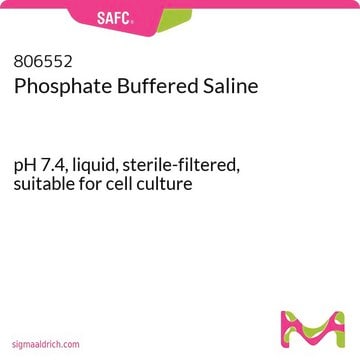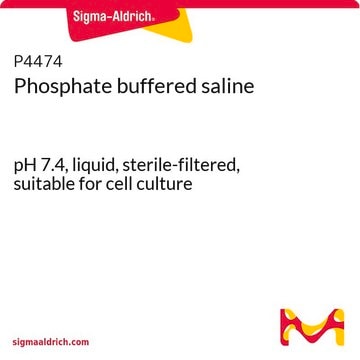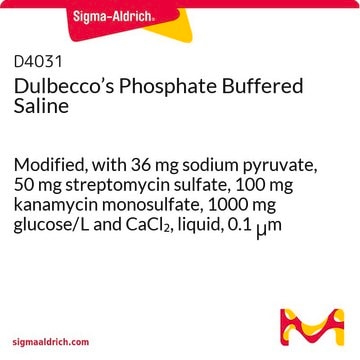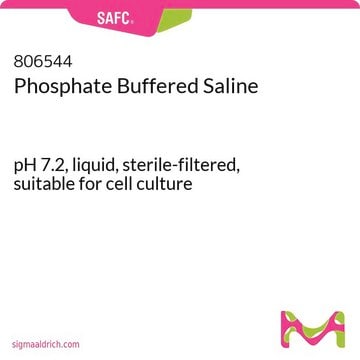D8537
Dulbecco′s Phosphate Buffered Saline
liquid, Modified, without calcium chloride and magnesium chloride, liquid, sterile-filtered, suitable for cell culture
Synonym(s):
DPBS
About This Item
Recommended Products
product name
Dulbecco′s Phosphate Buffered Saline, Modified, without calcium chloride and magnesium chloride, liquid, sterile-filtered, suitable for cell culture
Quality Level
sterility
sterile-filtered
form
liquid
technique(s)
cell culture | mammalian: suitable
impurities
endotoxin, tested
components
glucose: no (Dextro)
sodium pyruvate: no
shipped in
ambient
Looking for similar products? Visit Product Comparison Guide
General description
Application
- for the dilution of fresh red blood cells to study the trapping of red blood cell aggregate.
- to wash the wells of a microtiter plate.
- to wash the cells before resuspending them in lysis buffer for DNA isolation.
- as a component of embryo holding medium for vitrification of embryos.
also commonly purchased with this product
Storage Class Code
12 - Non Combustible Liquids
WGK
WGK 1
Flash Point(F)
Not applicable
Flash Point(C)
Not applicable
Certificates of Analysis (COA)
Search for Certificates of Analysis (COA) by entering the products Lot/Batch Number. Lot and Batch Numbers can be found on a product’s label following the words ‘Lot’ or ‘Batch’.
Already Own This Product?
Find documentation for the products that you have recently purchased in the Document Library.
Customers Also Viewed
Protocols
Cell culture protocol for passaging and splitting adherent cell lines using trypsin EDTA. Free ECACC handbook download.
Cell culture protocol for passaging and splitting adherent cell lines using trypsin EDTA. Free ECACC handbook download.
Cell culture protocol for passaging and splitting adherent cell lines using trypsin EDTA. Free ECACC handbook download.
Cell culture protocol for passaging and splitting adherent cell lines using trypsin EDTA. Free ECACC handbook download.
Related Content
Discover our primary human intrahepatic biliary epithelial cells, also known as cholangiocytes. Explore our plating and maintenance media formulations and protocol for culture.
Discover our primary human intrahepatic biliary epithelial cells, also known as cholangiocytes. Explore our plating and maintenance media formulations and protocol for culture.
Discover our primary human intrahepatic biliary epithelial cells, also known as cholangiocytes. Explore our plating and maintenance media formulations and protocol for culture.
Discover our primary human intrahepatic biliary epithelial cells, also known as cholangiocytes. Explore our plating and maintenance media formulations and protocol for culture.
Our team of scientists has experience in all areas of research including Life Science, Material Science, Chemical Synthesis, Chromatography, Analytical and many others.
Contact Technical Service










